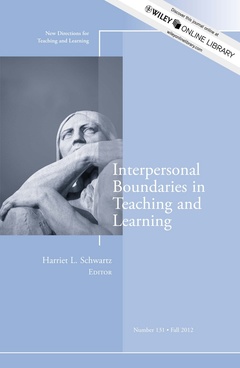Interpersonal Boundaries in Teaching and Learning New Directions for Teaching and Learning, Number 131 J–B TL Single Issue Teaching and Learning Series
Langue : Anglais
Coordonnateur : Schwartz Harriet L.

While issues of interpersonal boundaries between faculty and students is not new, ,more recent influences such as evolving technology and current generational differences have created a new set of dilemmas. How do we set appropriate expectations regarding e–mail response time in a twenty–four–hour, seven–day–a–week Internet–connected culture? How do we maintain our authority with a generation that views the syllabus as negotiable? Complex questions about power, positionality, connection, distance, and privacy underlie these decision points. This sourcebook provides an in–depth look at interpersonal boundaries between faculty and students, giving consideration to the deeper contextual factors and power dynamics that inform how we set, adjust, and maintain boundaries as educators. This is the 131 st volume of this Jossey–Bass higher education series. New Directions for Teaching and Learning offers a comprehensive range of ideas and techniques for improving college teaching based on the experience of seasoned instructors and the latest findings of educational and psychological researchers.
Editor&rsquo,s Notes 1 Harriet L. Schwartz 1. Boundaries and Student Self–Disclosure in Authentic, Integrated Learning Activities and Assignments 5 Melanie Booth Several contemporary pedagogies foster student self–disclosure in classrooms and within assignments. Exploring power, privacy, and the ethics of response, the author helps faculty reflect on how they design learning activities and respond to students&rsquo, sharing of personal information. 2. Managing Boundaries in the Web 2.0 Classroom 15 Bree McEwan Faculty members who use social media in their teaching face an array of boundary questions. The author provides a contextual understanding of various Web 2.0 spaces, helping faculty to more deeply consider boundaries with students, particularly regarding appropriate points of connection, self–disclosure, and availability. 3. Millennial Values and Boundaries in the Classroom 29 Chip Espinoza Exploring the concept of generations and the ways in which generational differences can lead to boundary conflicts, the author describes Millennial values and helps faculty understand how to bridge the generational divide while balancing their own values and Millennial students&rsquo, expectations. 4. We&rsquo,re All Adults Here: Clarifying and Maintaining Boundaries with Adult Learners 43 Melanie Booth, Harriet L. Schwartz Faculty members who teach adult students face unique boundary challenges as they may share similar life experiences with their students and may also be working from an andragogical perspective. The authors propose four strategies to help faculty establish, adjust, and maintain boundaries with adult learners. 5. The Coconut and the Peach: Understanding, Establishing, and Maintaining Interpersonal Boundaries with International Students 57 Miki Yamashita, Harriet L. Schwartz Interpersonal boundaries are culturally constructed and thus may be understood differently by American–born faculty and international students. The authors provide examples of intercultural misunderstandings and strategies for faculty members who wish to connect more effectively with international students. 6. Complicity or Multiplicity? Defining Boundaries for Graduate Teaching Assistant Success 71 Karen Dunn–Haley, Anne Zanzucchi Graduate teaching assistants (GTAs) face boundary challenges not only with the undergraduates they teach but also in the multiple–role relationships they have with senior faculty members. The authors describe a comprehensive development program designed to help GTAs cultivate their professional identities and respond to boundary dilemmas. 7. Crossing Boundaries in Doctoral Education: Relational Learning, Cohort Communities, and Dissertation Committees 85 Elizabeth L. Holloway, Laurien Alexandre Doctoral education has historically promoted a competitive individualistic culture among students and faculty. The authors describe their program in which program founders and faculty have reimagined doctoral education as a collaborative and connecting endeavor, they also share the boundary implications and adjustments needed to foster this culture change. 8. Reflection and Intention: Interpersonal Boundaries in Teaching and Learning 99 Harriet L. Schwartz Reflecting on this volume, the author identifies five themes: increase our awareness of power and positionality, examine reflexive boundaries, explore the assumptions we hold about our students, clarify expectations, and offer transparency. INDEX 103
Date de parution : 10-2012
Ouvrage de 120 p.
16.6x22.7 cm
Disponible chez l'éditeur (délai d'approvisionnement : 12 jours).
Prix indicatif 31,03 €
Ajouter au panier
© 2024 LAVOISIER S.A.S.



